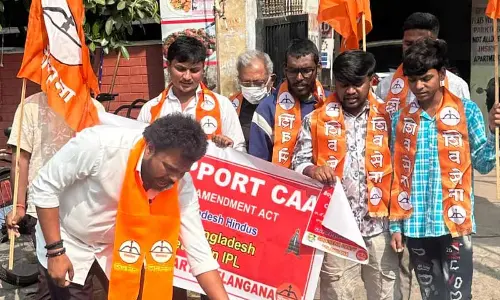The worst is yet to come

The Worst is Yet to Come. What is common between Hyderabad and Beijing? For that matter, what almost all major cities in the world have one thing in common with each other, notwithstanding the fact that they are separated by land and sea, language and culture and geographical peculiarities? What the metropolises across the globe share is a choking phenomenon called pollution.
What is common between Hyderabad and Beijing? For that matter, what almost all major cities in the world have one thing in common with each other, notwithstanding the fact that they are separated by land and sea, language and culture and geographical peculiarities? What the metropolises across the globe share is a choking phenomenon called pollution.
Little attention is paid to the widespread problem whose intensity and dimension could be seen only when people start wearing surgical masks or when there is a sudden rise in the number of cases with respiratory problems. The symptoms are physical in nature and visible. But the invisible damage the rising pollution levels are doing to human habitation in urban areas and flora and fauna in the countryside are immeasurable. The damage we are inflicting upon ourselves by reckless conservation of natural resources and burning of fossil fuels has been brought to the notice of governments and the people once again in a report prepared by the Inter-Governmental Panel on Climate Change and released in Yokohama, Japan, on Monday.

With hundreds of experts from various fields contributing to the study, it is the second of three reports that will form the basis for a global treaty on climate, expected to be signed in 2015. Once again, the panel has sounded alarm over deteriorating environment and how it is affecting the climate. The report said: “Ice caps are melting, sea ice in the Arctic is collapsing, coral reefs are dying, and fish and many other creatures are migrating toward the Poles or in some cases going extinct. The oceans are rising at a pace that threaten coastal communities and are becoming more acidic as they absorb some of the carbon dioxide given off by cars and power plants, which is killing some creatures or stunting their growth.”
Are we not familiar with such warnings made earlier in various reports submitted at international climate/environment conferences? Yes, indeed, we are. But, little has been done over the years.
Beginning with 1992 Earth Summit in Rio de Janeiro, Brazil, that brought together developed and developing countries to join in an international treaty -- United Nations Framework Convention on Climate Change (UNFCCC) -- to consider what to do against rising global temperature and the resulting climate change, and to cope with its impact, to Kyoto Protocol (December 1997) which set legally binding targets to reduce carbon emissions; 2007 climate talks in Bali, Indonesia; 2009 UN Climate Summit in Copenhagen, Denmark; Cancun conclave in 2010; Durban summit in 2011, followed by Doha meet a year later plus dozens of regional conferences organised by governments and NGOs, our progress report on climate change is dismal.
If the world has not been able to strike workable deals that satisfy all the stakeholders, notably China and India that are often accused of being two most polluting countries in the world, at global environment conferences, it is wishful thinking that the coming months would see a good deal of progress in reducing carbon emissions. However pessimistic we are about climate changes, we need to hear what the panel report says.
“Nobody on this planet is going to be untouched by the impact of climate change,” Rajendra K Pachauri, chairman of the Inter-Governmental Panel, said while releasing the report which has warned, among other things, “the worst is yet to come.” While an earlier report had warned of catastrophic effects of global warming, the latest one has looked at the effects of greenhouse gases on agriculture, economy, national resources and relations between countries.
Describing an apocalyptic scenario, the report says, “Throughout the 21st century, climate-change impacts are projected to slow down economic growth, make poverty reduction more difficult, further erode food security, and prolong existing and create new poverty traps, the latter particularly in urban areas and emerging hotspots of hunger.” Among other projections, the report has cited the risk of death or injury on a widespread scale, mass migrations, violent conflicts over land and water (we better mind our own country), poverty and hunger.
What is described in the report is consequences if we fail to heed scientists’ warnings and the present climatic state of the world that has been witnessing extreme weather patterns which should be regarded as wake-up calls. But the severity of the problem and the essence of environment reports are lost in the wrangling over development, West’s holier-than-though attitude towards developing countries, funding of research in renewable and green energy technologies and West’s limited aid offers to reduce carbon emissions. These and limited resources compel countries to look for alternative ways to save the environment and climate.
For India, the time has come to look at its pollution problems more seriously and devise own methods to tackle them. In other words, a micro level planning to reduce carbon use can go a long way in cutting emissions at macro level.
No doubt, India has initiated several steps to cut pollution levels. Still, we are far away from the goals set by our own environmental bodies, let alone global organisations. National level and country-specific targets could be achieved provided the governments concerned show urgency and realise the fact that the people’s future would be at stake if measures related to climate protection are not taken now. Both the people and their governments should see the danger lurking behind their backs, not as a shadow but as a reality that one day will start staring in the face menacingly.
In this regard, some of the suggestions of the Inter-Governmental Panel’s report are worth considering. For example, planning and implementation can be enhanced through complementary actions by different governments (in India’s case, state and central). The report says, “The overall risks of climate change impacts can be reduced by limiting the rate and magnitude of climate change.” Magnitude, probability or irreversibility are the criterion that need to be considered before launching the city-centric and nation-specific campaigns to lessen the impact of climate change on countries. In the global context, it will help slow the deterioration but not stall or reverse the damage. If we can do it at least to a limited extent, we will be doing a big favour to our future generations and a good deed to our planet Earth.
















